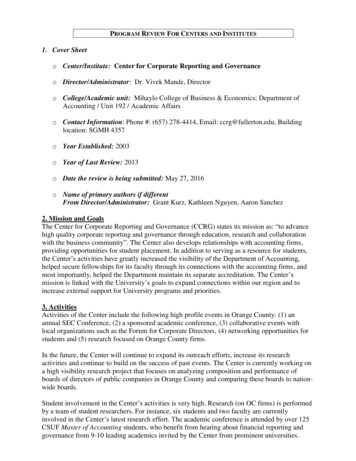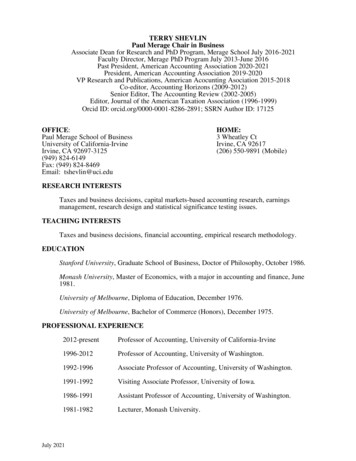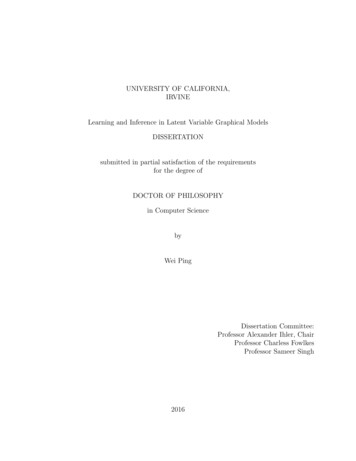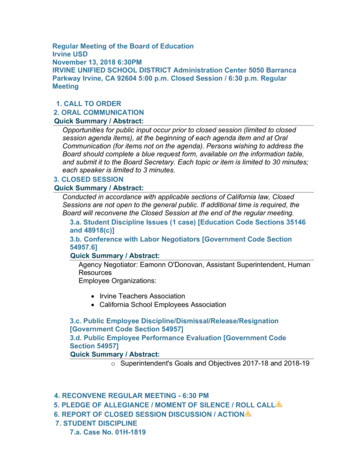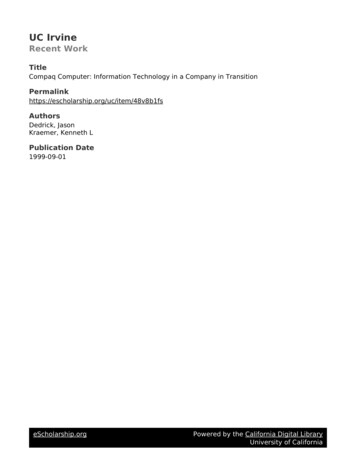
Transcription
UC IrvineRecent WorkTitleCompaq Computer: Information Technology in a Company in m/48v8b1fsAuthorsDedrick, JasonKraemer, Kenneth LPublication Date1999-09-01eScholarship.orgPowered by the California Digital LibraryUniversity of California
COMPAQCOMPAQ COMPUTER:COMPUTER:INFORMATIONINFORMATION TECHNOLOGYTECHNOLOGYCENTER FOR RESEARCHON INFORMATIONIN A COMPANY IN TRANSITIONTECHNOLOGY ANDORGANIZATIONSUniversity of California, Irvine3200 Berkeley PlaceIrvine, California 92697-4650SEPTEMBER 1999AUTHORS:Jason DedrickKenneth L. KraemerCenter for Research on Information Technology and OrganizationsUniversity of California, IrvineCopyright 1999. J. Dedrick & K. KraemerAcknowledgement:This research has been supported by grants from the CISE/IIS/CSS Division of the U.S. National Science Foundation and the NSFIndustry/University Cooperative Research Center (CISE/EEC) to the Center for Research on Information Technology and Organizations(CRITO) at the University of California, Irvine. Industry sponsors include: ATL Products, the Boeing Company, Bristol-Myers Squibb,Canon Information Systems, IBM, Nortel Networks, Rockwell International, Microsoft, Seagate Technology, Sun Microsystems, andSystems Management Specialists (SMS).
AbstractCompaq Computer, based in Houston, Texas, is the world’s largest personal computermanufacturer and the fourth largest information technology (IT) company. From 1992-1997,the company’s aggressive high volume PC strategy propelled it to high growth rates inrevenues, while its leadership in PC servers sustained strong margins and drove profit growth.Starting in 1995, former CEO Eckhard Pfieffer began to transform Compaq from a pure PCcompany to a full-service IT company that could compete with the likes of IBM and HewlettPackard. The key strategic moves were the acquisitions of Tandem Computer and DigitalEquipment Corporation in 1997 and 1998, giving Compaq a diverse line of technologies andservice capabilities.Compaq stumbled badly in 1998 as it faced new challenges in the PC market and tried toassimilate Tandem and Digital. In particular, Compaq struggled to catch up with DellComputer, whose direct sales, build-to-order model gave it a big advantage in cost and speedover Compaq’s indirect sales, build-to-forecast approach. When the company disappointedinvestors with poor results in 1999, the board removed Pfieffer and replaced him with MichaelCapellas. Since Pfieffer’s departure, Compaq has reorganized itself along business lines,streamlined its distribution channels and developed a new electronic commerce strategy called“NonStop eBusiness.”In 1994, Compaq began building a global enterprise information system to support itsmanufacturing and order fulfillment operations. The systems were built primarily aroundSAP applications, running on Compaq PC servers and the Windows NT operating system.Compaq’s IT people were forced to distribute the SAP applications across ten interconnectedsites around the world and customize extensively in order to run on Windows NT and meetCompaq’s needs. The company had a very centralized IT organization until 1998, but thestructure has started to change with the decision to break up the SAP group into separateteams for each major business unit. Further reorganization is likely to align IT with the neworganizational structure announced in 1999.
Compaq-case-9-99.doc3Table of ContentsI.II.III.IV.V.VI.IntroductionBusiness Environment and StrategyOrganization of Business ActivitiesCompaq’s Use of Information TechnologyFirm PerformanceConclusions4511132527Figures and TablesFigure 1. Compaq revenues, 1983-1998Figure 2. Compaq net income, 1983-1998Figure 3. Compaq stock price at FY close252627Table 1. PC and midrange server marketshare in revenues, 1997 and 1992Table 2. PC market share in units, 1998Table 3. Revenues and operating profits by region, 1998Table 4. Revenues by business line, 1998Table 5. Compaq online servicesTable 6. IT spending estimatesTable 7. Inventory turnover as of 1999551112212526Appendix A. Channel assembly programs of Compaq, IBM and HPAppendix B. Compaq’s IT structureCopyright 1999, Jason Dedrick and Kenneth L. Kraemer
Compaq-case-9-99.doc4COMPAQ COMPUTER:INFORMATION TECHNOLOGY IN A COMPANY IN TRANSITIONJason Dedrick and Kenneth L. Kraemer" Compaq does not currently have in place processes for order entry, production of individualized units anddirect distribution that can operate efficiently to manage a large portion of its current PC sales."Compaq form 10-Q, Quarter ending March 31, 1999I. INTRODUCTIONCompaq Computer, based in Houston, Texas, is the world’s largest personal computermanufacturer and the fourth largest information technology (IT) company. From 1992-1997,the company’s aggressive high volume PC strategy propelled it to high growth rates inrevenues, while its leadership in PC servers sustained strong margins and drove profit growth.Starting in 1995, former CEO Eckhard Pfieffer began to transform Compaq from a pure PCcompany to a full-service IT company, with the goal of becoming a 50 billion company thatcould compete with the likes of IBM and Hewlett-Packard. The key strategic moves were theacquisitions of Tandem Computer and Digital Equipment Corporation in 1997 and 1998,giving Compaq a diverse line of technologies and service capabilities.Compaq began revamping its information systems in 1994, building global enterpriseinformation systems to support its globally optimized manufacturing and order fulfillmentoperations. The systems were built primarily around SAP applications, running on CompaqPC servers and the Windows NT operating system in order to demonstrate that largeenterprise systems could run on Compaq hardware. Compaq’s IT people were forced todistribute the SAP applications across ten interconnected sites around the world andcustomize extensively in order to run on Windows NT and meet Compaq’s needs.Compaq stumbled badly in 1998 as it faced new challenges in the PC market and tried toassimilate Tandem and Digital. In particular, Compaq struggled to catch up with DellComputer, whose direct sales, build-to-order model gave it a big advantage in cost and speedover Compaq’s indirect sales, build-to-forecast approach. When the company disappointedinvestors with poor results in 1999, the board removed Pfieffer, who had been credited forCompaq’s previously stellar performance. Since Pfieffer’s departure, Compaq hasreorganized itself along business lines, streamlined its distribution channels and developed anew electronic commerce strategy called “NonStop eBusiness.”Compaq has gone through a series of IT reorganizations aimed at giving business units morecontrol over IT decisions and resources. Compaq’s new CEO, Michael Capellas, came to thecompany in 1998 as CIO and was the force behind this reshaping of the IT organization. It islikely that newly hired CIO Robert V. Napier will continue the process in order to align ITwith the new corporate structure, while also working to implement Compaq’s e-businessstrategies.Copyright 1999, Jason Dedrick and Kenneth L. Kraemer
Compaq-case-9-99.doc5II. BUSINESS ENVIRONMENT AND STRATEGYCompetitionCompaq sells PCs to corporations, small and medium enterprises (SMEs), governmentagencies and consumers in countries around the world. Major PC competitors include IBM,Hewlett-Packard, Dell, Gateway, Apple, and Toshiba, as well as many smaller branded PCmakers and thousands of companies making “white box” PC clones. Compaq, IBM and HPare the leading indirect PC vendors, selling through distributors, resellers and retailers—theso-called “channel.” Dell and Gateway are the leading direct vendors, selling directly to endusers.Compaq’s biggest challenge now comes from Dell, which has nearly caught up in U.S. marketshare and is gaining ground worldwide (Tables 1 and 2). Until recently, Dell’s growth camemostly at the expense of other PC makers, as Compaq continued to achieve high growth ratesand expanding market share. By the late 1990s, however, Dell was challenging Compaq in itskey corporate markets and Dell’s growth became a direct threat to Compaq. The Dell threatbecame more serious since Dell has introduced successful notebook and server lines,competing in Compaq’s most profitable market segments.Table 1. PC and midrange server market share in revenues, 1997 and 1992Worldwide PC market share (%)Worldwide midrange server market share 1.3Compaq15.8n.a.Dell8.53.6HP12.38.1Packard Bell6.91.8Sun8.5 2.3HP6.4 1.5DEC6.510.6Gateway5.1 ixdorf2.63.5Fujitsu3.31.6Dell2.6n.a.Source: McKinsey & Co. 1998 Computer Industry TrendsTable 2. PC market share in units, 1998Worldwide (%)Compaq13.8IBM8.2Dell7.9HP5.8Packard Bell/NEC4.3Gatewayn.a.Source: Dataquest press release, January 29, 1999U.S. (%)16.18.012.77.5n.a.8.4Since the acquisition of Tandem and DEC, Compaq has faced a new set of competitors inthose companies’ markets. For instance, Compaq now owns DEC’s Alpha processor,OpenVMS and Tru64 UNIX operating systems, and Tandem’s Himalaya fault-tolerantservers. This puts it in competition with companies such as IBM, Fujitsu, Sun and HP inCopyright 1999, Jason Dedrick and Kenneth L. Kraemer
Compaq-case-9-99.doc6high-end server markets. More importantly, the Tandem and DEC acquisitions broughtCompaq over 20,000 service professionals. Compaq has used these new technologies andservice capabilities to promote itself as a full-service IT company that can provide end-to-endtechnologies and services for large corporate customers. This puts it in competition with IBMand HP in enterprise systems and also with service providers such as EDS and CSC.StrategyCompaq’s business strategy has gone through three major phases during its seventeen years inbusiness. From 1982-1991, Compaq was a premium brand PC maker. It sold industrystandard IBM-compatible PCs, but distinguished itself by its design and engineeringcapabilities. Compaq was the first company to successfully reverse engineer the IBM PCBIOS, allowing it to sell IBM-compatibles, and was the first company to offer new designs(such as the first portable PC) and introduce new technologies such as PCs based on Intel’s80386 processor. During this period, Compaq targeted customers who needed high quality,well-engineered PCs and were willing to pay a premium for them. Compaq sold its PCsthrough a network of about 1,000 dealers in North America.1By 1991, Compaq’s growth was slowing and it faced competition from a slew of PC makerswho built low-cost IBM clones using standard designs and components. In Compaq’s secondstrategy phase, new CEO Eckhard Pfieffer moved to cut costs and recast the company as amass market PC maker. Compaq cut back on R&D spending (from 6% in 1991 to 2.1% in19942 ), reduced production costs by simplifying its designs and outsourcing some of itsproduction (largely to low-cost Asian manufacturers), and laid off 1400 employees as part of acost-cutting restructuring. Compaq changed its distribution strategy to reach new customerssuch as consumers and small business. It worked with distributors such as Merisel, Tech Dataand Ingram Micro to sell PCs to value added resellers (VARs) and expanded its retailpresence in stores such as CompUSA, Office Depot and Circuit City. 3Compaq also introduced new product lines for the home and small business markets andbecame the biggest seller of consumer PCs, which account for about 5 billion in annualrevenues. These moves were accompanied by major price cuts across Compaq’s product linesthat transformed Compaq from a premium brand into a price leader. Compaq’saggressiveness in the consumer retail market has nearly destroyed former leader Packard-Bell.The home and small business markets are low margin businesses for Compaq, but helped it toachieve high volume and lower average costs across its PC lines.A key part of Compaq’s success has been its leadership in the Intel-based PC server market,where it has consistently held a market share of over 30%. Working closely with Microsoft,Compaq was a leader in promoting Windows NT servers as lower cost alternatives to Unix inthe low end of the market. Compaq was also the first to offer NT workstations bundled with1Adrian Ryans and Mark Vandenbosch, 1995, “Compaq Computer Corporation 1995,” Richard Ivey School ofBusiness and Harvard Business School, HBS case #95A011.2McKinsey & Co., The 1995 Report on the Computer Industry, and The 1993 Report on the Computer Industry3Ryans and Vandenbosch, 1995.Copyright 1999, Jason Dedrick and Kenneth L. Kraemer
Compaq-case-9-99.doc7enterprise software such as SAP R/3, helping to move NT beyond the role of departmentalserver. This helped expand the PC server market and strengthened Compaq’s market position.Compaq’s strategies paid off handsomely. Sales tripled from 3.2 billion in 1991 to 10.8billion in 1994, and by 1995 Compaq was the number one selling PC brand worldwide.Success continued through 1997, with sales reaching 24.6 billion and return on investedcapital reaching a company record of 60.1%.4 However, Pfieffer had already began to moveCompaq to a third strategic phase in order to continue its high growth rates. He decided thatthe time had come to transform Compaq “from a PC company to a global IT—and Internet—leader.”5 No longer would Compaq be satisfied just to sell PCs; now it would challenge IBMas a provider of a full range of IT hardware, software and services for global corporations.This shift in strategy was highlighted by the acquisitions of Tandem and Digital EquipmentCorporation (DEC), which immediately expanded Compaq’s customer base and gave it accessto the technologies and service organizations of those two companies. Compaq felt that itcould not wait to develop the capabilities it needed internally and decided to acquire theminstead. DEC and Tandem had high-end server technologies, large sales and serviceorganizations, and an established presence in large corporate and governmental accounts. Thenew company is far different from the old one, now referred to as “Compaq Classic” withinthe company.DistributionCompaq sells PCs primarily through the indirect channel, reaching customers through anetwork of over 40,000 resellers worldwide. Compaq's channels consist of direct salesthrough Compaq’s sales force in accounts with over 1000 employees, two-tier sales throughdistributors and VARs and retail outlets for consumer products, and dealers and systemsintegrators for complex installations in commercial and government markets. Compaq offerstraining and certification programs for channel partners to support Compaq products andsoftware such as Microsoft Back Office and SAP R/3 running on Compaq hardware.Like other indirect PC vendors, Compaq has struggled to reduce inventory levels and matchsupply to demand. With PC components declining in value at 1% or more per week, holdinginventory is very expensive. Compaq has been accused at times of “stuffing the channel,” orshipping more product than it forecasts to sell, in order to push sales and market share. Whendemand lags, the channel must be cleared out, often at a loss, before new products can beintroduced. In these cases, dealers and resellers cut prices to move inventory, but Compaqtakes the loss because of price protection policies that protect the channel from price declines.The inefficiencies of Compaq’s distribution strategy were brought into focus in recent yearsby the success of Dell’s direct, build-to-order strategy. Dell was able to steadily increase itsinventory turnover to 60 times per year by 1999, while Compaq only turned its inventory over14 times. The difference in cost and time-to-market with new products put Compaq at a bigdisadvantage against its most aggressive competitor.45Compaq annual report, 1998.Compaq annual report, 1998.Copyright 1999, Jason Dedrick and Kenneth L. Kraemer
Compaq-case-9-99.doc8“To get a sense of Dell's edge, consider the travels of a typical Compaq PC sold to a corporation.Based on often hazy forecasts of demand, Compaq builds a machine. Then Compaq tests, inspects, boxes, andstores the PC before sending it to a reseller's warehouse, where the machine sits until a customer finally puts inan order. Until recently, that wait has averaged six to eight weeks. Of course, each customer's computing needsare slightly different. So once the reseller receives an order, the computer is unpacked, its case is opened, partsare installed or removed, the case is closed, software is loaded, and the whole thing is tested, inspected, packed,and shipped to the customer. IBM and HP send their products on similar treks.” 6Optimized Distribution ModelCompaq recognized the problems with its distribution system and began to develop its ownbuild-to-order strategy in 1994. The strategy was broadened in 1997 into what Compaq callsits Optimized Distribution Model (ODM). "ODM signals the beginning of a new era atCompaq ," according to Eckhard Pfeiffer. "With the launch of ODM, we are sending a shockwave through the industry.The new model will shape the way all Compaq products aredesigned, built, configured, distributed, ordered, purchased, serviced, and upgraded, as well asthe way Compaq engages customers and works with its reseller partners."7 Two years later,however, Compaq was still revising ODM, and had fallen far short of its inventory goals.What is ODM, and why has Compaq had such trouble implementing it? ODM is a strategyfor linking Compaq’s supply chain from supplier to final customer to execute build-to-orderproduction within an indirect sales model. The goal of ODM is to deliver 95 percent of allproducts anywhere in the world within five days or less.ODM has three elements: Build to order (BTO), where Compaq builds standardconfigurations to orders that come in from channel; configure to order (CTO), where Compaqbuilds nonstandard configurations from a list of approved components; and the ChannelConfiguration Partner program (CCP), or channel assembly, where Compaq authorizeschannel partners to build systems on its behalf using components supplied by Compaq.8BTO was the simplest part of the model; it simply said that Compaq would manufacture itsPCs when the order came in instead of building and shipping to forecast. CTO required a shiftin production to incorporate more customization, but production remained under control ofCompaq. CCP, or channel assembly, required the greatest changes on the part of Compaq andits channel assembly partners (CompuCom Systems, Inc., ENTEX Information Services, Inc.,GE Capital Information Technology Solutions, Inacom Corp., Ingram Micro Inc., MicroAgeInc., Tech Data Corporation and Vanstar Corporation). Final assembly and configuration wasshifted from Compaq’s plants to those of its channel partners, which theoretically would savetime and costs by eliminating the need for additional configuration after final assembly tookplace. However, the realization of these savings was hampered by difficulties in execution.6“Now Everyone In PCs Wants To Be Like Mike. Michael Dell, That Is.” David Kirkpatrick Reporter,Associate Patty De Llosa, Fortune, 09/08/1997, Page 91 7John Teresko, 1998, “Replacing Inventory With IT,” Industry Week, 5/4/98, page 388Peter Jordan, “Assembling Channel Assembly -- A long time coming, channel assembly is just now rolling outthe door,” VAR BUSINESS 6/8/1998.Copyright 1999, Jason Dedrick and Kenneth L. Kraemer
Compaq-case-9-99.doc9There are several reasons that ODM has failed to achieve its goals. One was the acquisitionof DEC, which forced Compaq to shift a great deal of its energy into assimilating DEC andtook attention away from ODM. Equally important was Compaq’s unwillingness to let theprogram work if it risked losing some sales volume. Rather than wait for orders to come in, itcontinued to push products into the channel in order to increase sales and market share. Thefirst reckoning came in early 1998, when Compaq was caught with excess inventory in thechannel and saw its profits disappear.“The company felt a more dramatic shift to ODM and a trimming of dealer inventories might hurt revenue, saysWalter Winnitzki, analyst at PaineWebber in New York. To cushion the blow, Compaq continued to pump moreproducts into the channel based on demand estimates and hoped to spur more sales, Winnitzki says. Compaqalso had its eyes on expanding its market share, and it may have been willing to take risks to achieve that goal,some analysts say. Those risks proved too great when competitors IBM Corp. and Hewlett-Packard Co. quicklyjoined in on a round of price cutting initiated by Compaq.”9Another problem with ODM has been its complexity. In North America alone, Compaq had10,000 resellers, dealers and retailers selling Compaq products, supplied by 39 channelpartners (18 corporate resellers, 12 distributors and nine direct response/retailers), whobought directly from Compaq. These 39 channel partners held inventory in 100 warehouses,in addition to inventory held by other resellers, dealers and retailers. Under the best ofconditions it was difficult to implement a build-to-order system that would process ordersquickly and keep inventory under control.In addition, Compaq was trying to achieve several goals with ODM, leading to a complicatedsolution. Compaq wanted to reduce inventory by building PCs to order, yet it wanted tomaintain product availability throughout the channel, which normally was done by keepingsufficient inventory in the channel. Also, it wanted to offer configure-to-order service so thatresellers would not have to open up the box and make final configurations for end users. Thisled to the creation of a three-part model whose complexity nearly matched that of theproblems it was trying to solve.One issue raised about channel assembly is processor plug-in, i.e., whether the channelassembler can install the microprocessor and do the burn-in process. By 1998, IBM andHewlett-Packard were letting resellers plug processors into motherboards, but Compaq washolding out, fearing a loss of quality control.Without processor plug-in, however, some of the time saving benefits of channel assembly arelost. According to VARs, processor plug-in gives them greater flexibility in system assemblywhile significantly reducing inventories. They say the problem with having the vendor dosystem testing is that the processor and some memory need to be installed on the motherboardin order to burn-in the system. Once the processor and memory installed, the vendor hascreated a partially finished system that must be shipped from the vendor to the channelassembly facility, and then to the user, a process that can add up to 10 shipping days.109Nick Turner, “Computers & Technology Compaq 's Best Laid Plan For Inventory Goes Awry,” Investor'sBusiness Daily, 7/14/1998, Page A810Craig Zarley, “Compaq reshapes channel landscape,” Computer Reseller News, 5/10/1999, Page 1Copyright 1999, Jason Dedrick and Kenneth L. Kraemer
Compaq-case-9-99.doc10One response to the problem of having to ship twice was to co-locate Compaq’s majorchannel configuration partners at Compaq plants, so that shipment of the partially finishedsystem was eliminated. In 1998, Compaq announced a co-location agreement withdistributor CompuCom Systems at Compaq’s Houston campus. CompuCom’s ConfigurationServices Center performs final assembly, software loads and advanced configuration serviceson Compaq desktop PCs, workstations and servers.11 In addition to CompuCom, Compaqestablished co-location partnerships with Tech Data in and Ingram Micro as part of itsPartnerDirect plan in 1999.The pressure from Dell and Gateway led each of the three major indirect vendors to developtheir own versions of channel assembly (see Appendix A). However, channel assembly hasbeen a frustrating experience for both vendors and channel partners. For instance, participantsin IBM’s Authorized Assembler Program need to invest 5 million to equip themselves forprocessor plug-ins, on top of requirements to buy a minimum of 150 million worth ofproduct and spend 150,000 to obtain ISO 9002 certification. In addition IBM, HewlettPackard and Compaq require resellers to invest in proprietary versions of shop-floor softwarenecessary for processor plug-in, significantly adding to their costs.12Other problems with channel assembly involve the need to revamp information and logisticsflows. Every Compaq channel partner uses different systems and Compaq had to create linksbetween its own information systems and the different systems used by its channel assemblypartners. Ray Robidoux, Compaq vice president of ODM operations, said that Compaq’stimetable for processor plug-in "partially depends on the channel's ability to get their[electronic data interchange] systems and testing capabilities in place."13Direct SalesIn November 1998, Compaq began offering direct sales to end customers over its DirectPlusweb site. Under the “Customer Choice” banner, Compaq allowed customers to buy PCsdirectly from Compaq, through traditional resellers, or at kiosks in retail outlets.The decision was driven by the fact that an increasing number of customers wanted to buydirectly from the vendor, often over the Internet, and Compaq was not willing to cede thismarket to Dell and Gateway. "We have simply decided that we are not going to miss out onthat one-third of the total market," Pfeiffer said.14In spite of Compaq’s efforts to appease its channel partners, which included a 6% agent feepaid to VARs when their customers used the DirectPlus program, the decision to sell directcreated serious misgivings among Compaq’s distributors and resellers. These channelmembers feared that Compaq would compete with them on price for the same products.11“CompuCom ‘Co-Locates’ with Compaq to Increase Manufacturing Efficiency and Reduce Product DeliveryTime and Cost,” Business Wire, 7/7/98.12Jeff Bliss, “Expense May Thin Ranks Of AAP Plan,” Computer Reseller News, April 13, 1998.13Craig Zarley, “Compaq reshapes channel landscape,” Computer Reseller News, 5/10/1999, Page 114Dwight Silverman “Compaq saw writing on the wall /Customers demand direct sales mode” HoustonChronicle, 11/12/1998, Page 1Copyright 1999, Jason Dedrick and Kenneth L. Kraemer
Compaq-case-9-99.doc11DirectPlus bypassed distributors completely, and channel partners feared that it was a step inthe direction of bypassing the channel altogether.15After hearing complaints from the channel about DirectPlus, Compaq announced a pilotprogram called PartnerDirect which involved distributors in the fulfillment of direct ordersand offered more favorable distributor and reseller terms. A major component ofPartnerDirect is the co-location of two distributors—Ingram Micro and Tech Data—inCompaq’s Houston plant. When VARs place an order through PartnerDirect, Compaq willmanufacture the basic system and the distributor will install third-party components, configurethe system, provide financing and ship the order to the end user or to the VAR. 16In June, 1999, Compaq announced it would open 17 new call centers to take orders, with agoal that 25% of sales will be direct by the end of the year.17 In 1999, it also announced directsales in Europe and Japan.Distribution Alliance Program: Streamlining the channelAfter the firing of Eckhardt Pfieffer, Compaq’s first major move was to streamline itsdistribution channel, announced on May 10, 1999. A new program called the DistributionAlliance Program (DAP) was hailed by Compaq as “the biggest change we have made in ourhistory." DAP cuts the number of distributors who buy directly from Compaq from 39 to justfour alliance partners—Ingram Micro, Inacom, Merisel and Tech Data (Although not part ofthe Alliance, CompuCom, as a co-located Compaq integrator, will continue to provideintegration and configuration services for direct large-account sales). As of August 1, theother 35, along with all of Compaq’s resellers, had to purchase Compaq PCs from the fouralliance partners. As a result, the number of inventory stocking points in North America wascut from 100 to just 30, which is expected to improve inventory control and ensure productavailability for resellers. 18III. ORGANIZATION OF BUSINESS ACTIVITIESIn the past, Compaq organized its business segments on a geographic basis. Profits and losseshistorically have been reported for three regions: North America, EMEA (Europe, MiddleEast and Africa), and other (including Japan, Greater China, Asia-Pacific and Latin America).The bulk of Compaq’s revenues come from North America and Europe, although it is amarket leader in a number of Latin American and Asian markets (Table 3).Table 3. Revenues and operating profits by region, 1998 (in millions)North AmericaRevenues13,411Profit1,666Source: Compaq 1998 annual report15EMEA10,1351,845Other3,720339Jan Stafford, “Compaq Expands Direct Effort, But VARs and distributors will play bigger role in Compaq'splan,” VAR Business, March 26, 1999.16Stafford, 199917Matt Hamblen and Kathleen Ohlson “Compaq : Reality Sinks In,” ComputerWorld, 6/21/1999, Page 3018Craig Zarley, “Compaq reshapes channel landscape,” Computer Reseller News, 5/10/1999, Page 1Copyright 1999, Jason Dedrick and Kenneth L. Kraemer
Compaq-case-9-99.doc12Until 1999, business lines were divided among PCs (commercial and consumer), enterprisesystems (Alpha, Tandem and Intel servers, workstations, storage) and services. Thebreakdown of revenues is presented in Table 4, which shows that Compaq is still primarily ahardware company, even after its acquisition of DEC’s large service business.Table 4. Revenues by business line, 1998 (% of total)Commercial PCsConsumer PCsEnterprise systemsServicesSource: Hoover’s Online37163413In June 1999, Compaq announced that it would formally reorganize its businesse
Compaq's business strategy has gone through three major phases during its seventeen years in business. From 1982-1991, Compaq was a premium brand PC maker. It sold industry standard IBM-compatible PCs, but distinguished itself by its design and engineering capabilities. Compaq was the first company to successfully reverse engineer the IBM PC



